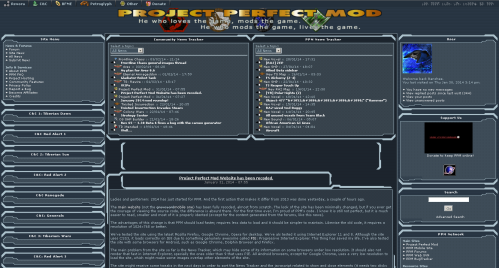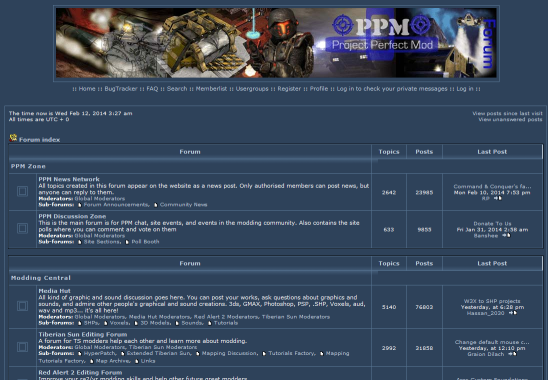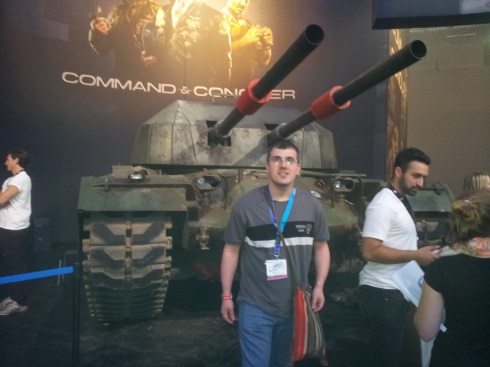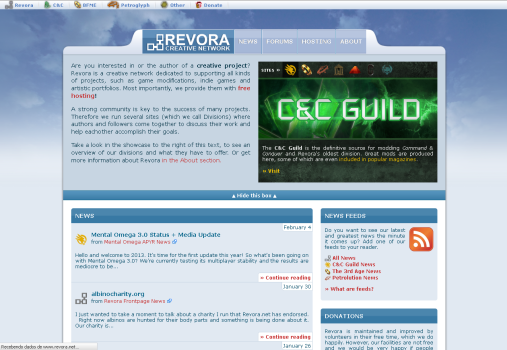Sites
The networks presented at this section received significant contributions from Carlos Eduardo Vaisman Muniz, who has also developed the code and the layout of this site.-
 Project Perfect Mod (PPM) is an online community that promotes the development of:
Project Perfect Mod (PPM) is an online community that promotes the development of:
- game modifications,
- indie games & game engines,
- development tools,
- user created maps and content,
- etc.
It hosts them and also provides tutorials, development tools, maps, etc. The content is produced by the community for the community. The site provides news targeting gamers, game and mod developers. These news cover the hosted projects, related projects that are in other networks and the games that inspire this community. Eventually, there are contests organized by community members and other events.
Carlos is the webmaster of the site. He codes it, updates it, organizes its finances, structure and events.
Visit: http://www.ppmsite.com
-
 Project Perfect started in 2000 as a game modification for Command & Conquer: Tiberian Sun. As one of the founders of the project, Carlos has gained administrator status at its forums in august 2002.
Project Perfect started in 2000 as a game modification for Command & Conquer: Tiberian Sun. As one of the founders of the project, Carlos has gained administrator status at its forums in august 2002.
Since then, the popularity of the site has grown attracting a big community of modders who were interested in Tiberian Sun and Red Alert 2, which had similar modding mechanics. It started to host tutorials, attract programmers who coded tools to help modding these games and a Red Alert 2 mod project called Red Generals. Project Perfect Mod started to attract other mods, support newer games like Command & Conquer: Generals and organize modding and mapping contests. Carlos also started to work on tools like Open Source SHP Builder, Voxel Section Editor III, Open Source: Voxel Viewer, Open Source HVA: Builder, among others.
In 2006, one of the mapping contests, known as Open Map Competition 3, has attracted the attention and sponsorship from Electronic Arts, the company whose the rights of the Command & Conquer franchise belongs to. With the upcoming release of Command & Conquer's next game, Tiberium Wars, Electronic Arts has invited Carlos to visit their studios at Los Angeles at the end of 2006 to collect his feedback about the game.
With Tiberium Wars's release in 2007, Carlos has coded the Open Source BIG Editor, which was the first tool to open its .BIG packages, allowing some of the game settings to be modified, as shown in in this tutorial. It has attracted Tiberium Wars modders and map makers, transforming PPM into one of the most important Command & Conquer 3 modding communities in the web, specially once the official Mod SDK was released for this game.
Also, since Tiberium Wars release, Carlos has been researching ways to convert the volumetric models used in Tiberian Sun and Red Alert 2 into 3D models for newer games and it has been part of his academic life. In his final project to earn his computer science degree, he has developed a method to transform these models into smoothed polygonal models and few months later he has also developed a way to extract texture coordinates from it automatically. It was published as a full paper at the SBGAMES 2010 conference. Unfortunately, the polygonal models that were obtained with this method were not manifolds and the texture maps that were generated were not satisfactory to be actually used in games. So, in 2012, in his master degree, Carlos has managed to transform volumetric models into manifolds, which was published as a full paper at SIBGRAPI 2013, at Arequipa, Peru. The next step is to obtain a proper texture map and in his doctorate, Carlos is developing a new data structure that should aid him in that mission.
-
 Project Perfect Mod has expanded over the years, with the new Command & Conquer games that were released by EA (including invitations for community summits for these games that Carlos couldn't attend due to budget problems from the company, although in 2009 he has sent a friend for the event). With the fall of EA Los Angeles Command & Conquer team, Project Perfect Mod has taken small steps to cover non-Command & Conquer games.
Project Perfect Mod has expanded over the years, with the new Command & Conquer games that were released by EA (including invitations for community summits for these games that Carlos couldn't attend due to budget problems from the company, although in 2009 he has sent a friend for the event). With the fall of EA Los Angeles Command & Conquer team, Project Perfect Mod has taken small steps to cover non-Command & Conquer games.
In 2011, Electronic Arts has announced a new Command & Conquer game, which would be free to play. In 2013, EA has brought members from several fan sites to the GAMESCOM convention in Cologne, Germany, to provide feedback for their new game. Carlos was also invited and, despite the expensive flight costs for EA, Carlos could attend the event this time. Unfortunately the game was cancelled two months later for reasons beyond our comprehension.
-
 Revora is an online community like PPM, but it is not restricted to develop games and modifications.
Revora is an online community like PPM, but it is not restricted to develop games and modifications.
It may cover any topic that interests the community. Each topic is expanded in a division site, such as CnC Guild (for Command & Conquer games), The 3rd Age (for games based in the Lord of the Rings novel), Petrolution (for games created by Petroglyph Games, etc. It hosts any kind of content about these topics, from articles to tutorials, downloads, mods, user created content, etc.
Revora has its own dedicated server that is also used to sell hosting services for other sites, such as Project Perfect Mod.
Revora is represented in all financial and legal matters by the Revora Association. It is a voluntary and non-profitable association based on Swiss law.
Carlos currently contributes with the maintenance of the network and the server. He is also a member of the General Assembly from Revora Association.
Visit: http://www.revora.net
This site was developed by Carlos Eduardo Vaisman Muniz. It uses CSS3 and it requires a browser that supports this technology such as Mozilla Firefox 5+, Google Chrome 10+, Safari 5+, Opera 11+ or Internet Explorer 9+.


